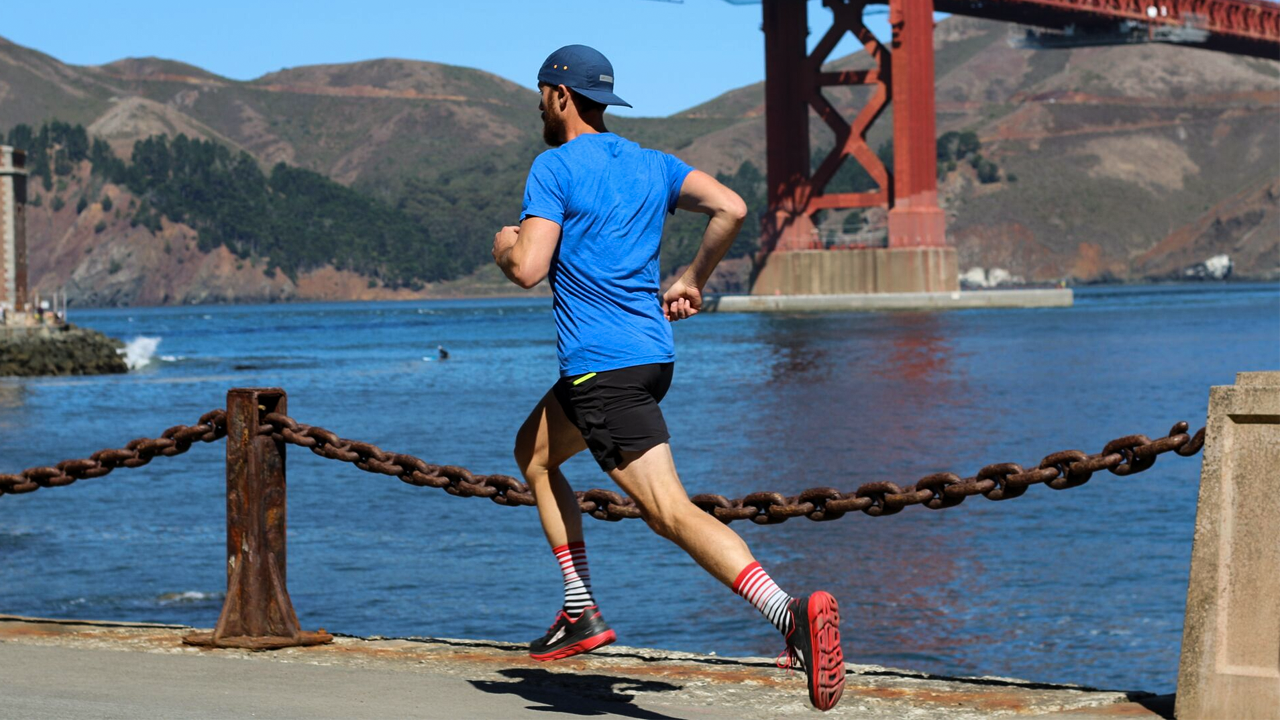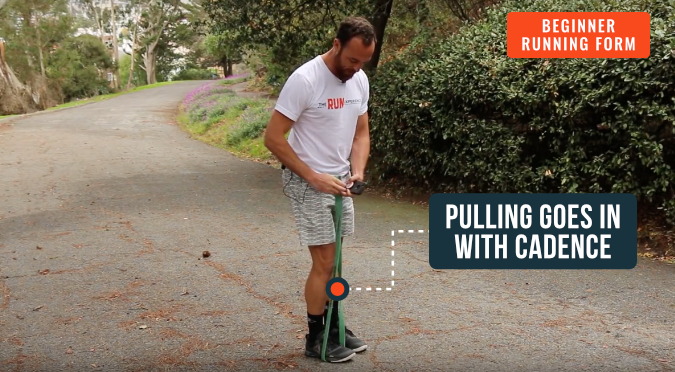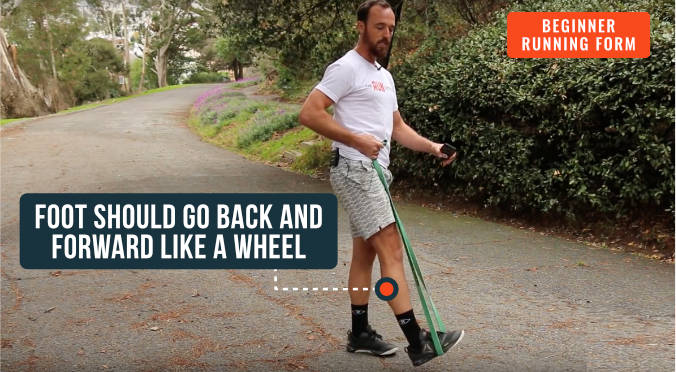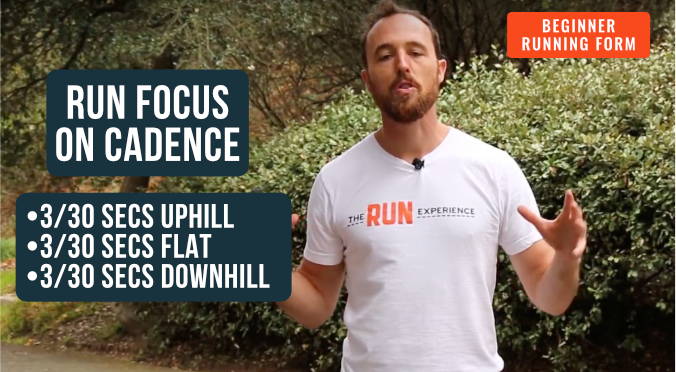Running Stride Length: How to Find Your Perfect Stride
Changing your running stride length can improve your speed. Use these running form drills to improve your strides.

Your running stride length is personal to you, but it’s also something you can improve. You’ll hear talk about “good stride lengths,” “bad stride lengths,” “average stride lengths,” and all that mumbo-jumbo.
It’s important, but not as important as finding your perfect running stride length.
Did you know that running is just like riding a bike? It’s all about practice, repetition, and being mindful of what you’re doing—and doing it over and over again. Learn the secrets to your stride with this post on finding your best running stride length.
What Is a Stride Length in Running?
Your stride is usually the distance between when one leg pushes off and when the next leg lands—and the distance between is known as your stride length. It's measured from the point where one foot touches the ground to the point where the same foot touches the ground again, involving the entire cycle of a leg moving forward and then back to its starting position.
This measure can significantly influence your speed and efficiency as a runner.
There are two main factors in running performance: stride length and stride frequency (or cadence). Stride length refers to the ground you cover with each step, while stride frequency refers to how often those steps are taken. Finding the optimal balance between the two can lead to more efficient running, potentially reducing injury risk and improving speed.
Several factors can affect your stride length, including height, leg length, muscle strength, and flexibility. While some of these factors are genetic and unchangeable, others can be improved through targeted training. For example, exercises that increase leg strength and flexibility can help extend your stride length, while plyometric training can improve your power and speed, allowing for a longer stride.
How to Measure Stride Length
Measuring your stride length is a practical step to understand your running mechanics better and identify areas for improvement. Here are methods and tools you can use to measure your stride length accurately:
Manual Measurement Method
- Marked Track or Flat Surface: Find a flat and measurable surface, like a track or a straight path marked with distance measurements.
- Count Your Steps: Run at a comfortable pace for a set distance, such as 100 meters or 100 yards. Count the number of steps you take.
- Calculate Stride Length: Divide the total distance by the number of steps. For example, if you run 100 meters and take 50 steps, your average stride length is 2 meters (or about 6.56 feet) per stride.
Using Technology
- Wearable Devices: Many running watches and fitness trackers can automatically calculate your stride length. These devices use accelerometers and GPS to estimate how far you move with each step.
- Smartphone Apps: Some running apps can also calculate stride length using the phone's built-in sensors. Ensure your phone is securely attached to your body for accurate measurements.
- Running Pods: Devices like running pods attach to your shoe and connect to a smartphone or watch, offering detailed data on stride length, cadence, and other running metrics.
Tips for Accurate Measurement
- Consistent Conditions: Measure under similar conditions (e.g., flat surface, same running pace) to ensure consistency.
- Multiple Measurements: Take several measurements to find an average stride length, as it can vary with pace and fatigue.
- Consider Variability: Your stride length can change based on speed, terrain, and fatigue level. It might be useful to measure it under different conditions to understand how it fluctuates.
How to Find Your Perfect Running Stride Length
You’re In Control Of Your Speed
Biking requires you to both push AND pull with your legs. This combination allows you to move across varying terrain at various speeds and effort levels.
Whenever you get to a hill on your bike, what do you do? You switch to a smaller gear. And when you get back to the flat, you switch to a larger one.
Well…believe it or not, running works the same way. You’ll need those same pushing and pulling motions to take control. Uphills will demand a shorter, smaller stride length, flats will demand a longer, neutral stride and downhills will demand the longest stride length of all.
So, how do you go about alternating between the three?
Understanding Cadence

You hear distance runners talk a lot about their cadence.
Assuming that if you’re reading this, you may be navigating your way around your first few months of running and are unfamiliar with the subject.
So, let us explain! Your cadence is your stride rate, or the number of steps it takes for your foot to hit the ground per minute.
No matter what level of athlete you are, we like to encourage an average stride length (or cadence) of somewhere between 85 and 90 (that’s the # of times one of your feet will hit the ground per minute).
This number encourages proper biomechanics–improving running form, a healthy posture, and the least opportunity for “marathon shuffle” and resulting impact injuries, etc.
How Do You Switch Gears?

So now that we understand our stride length and cadence, how do we blend them together to take control of our speed? Stride length is best controlled by the hamstrings.
When the hamstrings are activated, the heels can actively pull up toward the glutes. This encourages healthy tension through the midline as well as less opportunity for injury.
As Coach Nate demonstrates in the video, you can use a rogue monster band to most easily activate the hamstring pull in your run stride. Once we’ve got those firing, we can see that the legs operate like wheels. Your stride works in a rotation that can be made smaller or larger.
Now, back to our cadence. We suggested a cadence of somewhere between 85 and 90. This is encouraged for all types of terrain, no matter what your running style is! Uphill, flat, downhill…it is all the same.
So, this is where your gears come in! To keep the stride frequency the same, you’ll have to adjust the length of your stride, the size of your rotation. Uphills will require short strides, and downhills will require longer strides.
Let’s practice to find the perfect stride!
A Practice Drill For Controlling Your Stride

Before we get going, you’ll want to gain access to a metronome or something that will allow you to hear the stride rate you’re aiming for.
We like this one.
Here’s the drill:
- Set your metronome to somewhere between 85 and 90–that’s the number of times your right foot (or left) should hit the ground in one minute.
- Your right or left foot will hit the ground on each beep.
- You’re going to run for 30 seconds up a hill, holding onto this cadence.
- Jog back down as a rest.
- Repeat twice more.
- Now, with the same cadence, you’ll run 30 seconds on a flat piece of land.
- Jog back to rest.
- Repeat twice more.
- Finally, holding the same cadence, you’ll run 30 seconds on a downhill.
- Walk back up to rest.
- Repeat twice more.
Here’s the kicker:
The only way to keep your feet hitting the ground at the same rate across three different types of terrain is to change the length of your stride.
Keep it short on the uphills, medium on the flats, and as elongated and hip-driven as possible on the downhills. This is a great way to practice switching gears as you run. It will also help you manage your effort output during your long runs for optimal running performance.
Try throwing it into your training routine once a week!
Frequently Asked Questions
What’s a good stride length?
That’s personal to you. You might have a faster turnover rate and run better with shorter stride lengths. Your height, weight, and experience will all play a part in your stride length. Don’t force it. Continue to train and incorporate these drills to find the right stride length for you.
What’s the average stride length when running?
Does it matter? Everybody is different, and longer legs, shorter torsos, running injuries, and even footstrike will all impact your stride length. The average stride length is just an average—but you’re not average. You’re unique and special.
The average stride length for running varies significantly among individuals due to a variety of factors, including height, leg length, physical condition, and running style. Typically, an average stride length can range between 2.5 to 3 feet for many runners. However, elite athletes, especially sprinters, can have a much longer stride length, sometimes exceeding 6 feet, due to their exceptional speed and power.
While the concept of an "average" stride length offers a baseline, it's crucial to understand its relative importance and individual variability:
- Personal Biomechanics: A person's biomechanics, including leg length and muscle composition, naturally influences their stride length. Attempting to conform to an average without considering your unique biomechanical structure can lead to inefficiency and injury.
- Running Economy: Stride length should contribute to an efficient running economy, which is the energy cost of running at a certain speed. An optimal stride length for one runner may differ for another, even if they are of similar heights and builds, due to differences in muscle strength, flexibility, and running technique.
- Footstrike and Posture: The way a runner's foot strikes the ground (forefoot, midfoot, or heel strike) and their overall posture can affect stride length. Adjusting these elements for better performance should be done with caution and ideally under professional guidance to avoid injury.
- Injuries and Conditioning: Past injuries and the current level of conditioning also play significant roles. A runner recovering from an injury may have a shortened stride length temporarily. Similarly, improved conditioning over time can lead to changes in stride length and efficiency.
Given these factors, focusing on your "average" stride length may not be as beneficial as understanding and optimizing your own stride for comfort, efficiency, and injury prevention. Working with a coach or using video analysis can help identify your natural stride pattern and suggest adjustments if necessary.
Find Your Stride Length—Train Like a Pro
For sticking with us to the end, check out our range of running training programs, catering all the aspects of run, strength and mobility training! Every workout is easy to follow, backed by awesome coaching support and requires NO equipment!
Finally, don’t forget to download our new mobile app for access to coaching advice, daily video workouts, injury prevention tips, and complete training programs that will help motivate and inspire your training program!
